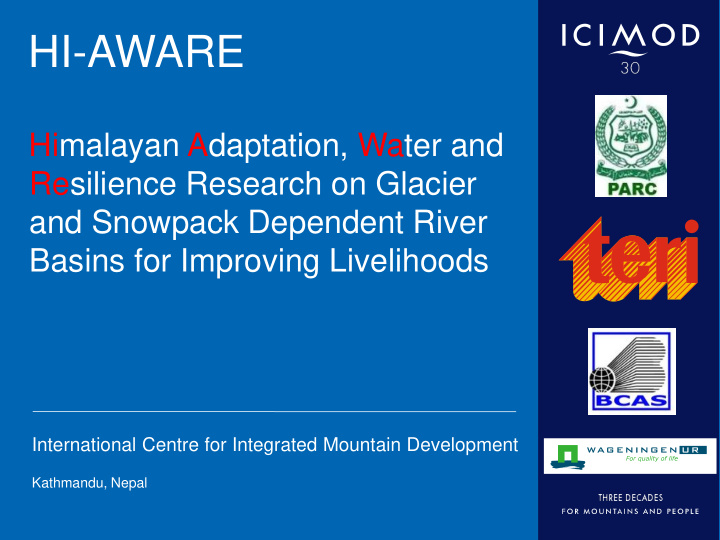



HI-AWARE Himalayan Adaptation, Water and Resilience Research on Glacier and Snowpack Dependent River Basins for Improving Livelihoods International Centre for Integrated Mountain Development Kathmandu, Nepal
HI-AWARE Goal • Enhance the adaptive capacities and climate resilience of the vulnerable • in the mountains and plains of the river basins of the Hindu Kush Himalaya (HKH) region, • through the development of robust evidence to inform people-centred and gender sensitive climate change adaptation policies and practices. Photo Source: S. Kohshima (1982) and K. Fujita (1996, 2008, 2009)
The Hindu Kush Himalayas 210 million people in the HKH region 1.3 billion people downstream
The Third Pole: Climate Change Hotspot Himalayan glaciers are sources The third pole on earth of freshwater reserves for 10 - an area of extraordinary major river systems in Asia – a beauty and a world heritage lifeline for almost one third of site of cultural and humanity biodiversity
Himalayan glaciers are shrinking Note: Brackets include name of glacier or region with associated number/area (km2) of glaciers studied if more than one single glacier; U=Uttarakhand, HP=Himachal Pradesh Source: Miller et al. (2011)
Source: Immerzeel et al., 2011
Contributions Glacier and Snow Melt to Runoff 1998-2007 Seasonality, critical moments Source: FutureWater, ICIMOD, 2013
Upstream – Downstream • Changes in the mountains impact people living downstream • Shrinking of glaciers leads to increased streamflow (peak melt 2050 – 2070) + GLOFs • A shift in timing of high precipitation events, falling as rain rather than snow, can lead to floods as well
Increased high rainfall events Increased temperatures and extremes Variability in monsoon
Outcomes and Impacts HI-AWARE Impact: Enhanced climate change resilience and adaptive capacities in the HKH region HI-AWARE Outcomes: 1) Up-scaling and out-scaling of institutional and on- the-ground adaptation innovations 2) Improved policies and practices that help vulnerable populations to adapt to climate change
WP 1: Generate Knowledge • Generate science-based and people- centred knowledge , with an explicit focus on gender and livelihoods, • on climate change impacts and adaptation measures in the mountains and plains of the rivers basins of the HKH region • through integrative, stakeholder-driven , and policy-oriented research
WP 2: Research Uptake • To promote the uptake of the robust evidence generated in WP 1 • through developing synergies between science-based knowledge and adaptation practices of communities • to shape improved policies and practices that help vulnerable populations to adapt to climate change.
WP 3: Strengthen Expertise • To further strengthen the scientific expertise in climate change adaptation and resilience research in the region • to contribute to improving climate change adaptation science-policy-practice networks in the HKH region.
Overall Programme Design
Approach Tackling Vulnerability through Adaptation leads to Increased Resilience
Climate and Adaptation Research • Biophysical drivers and conditions leading to vulnerability CC Impacts (glacier/snow melt, T, p, Q, ) • Socio economic and governance drivers and conditions leading to vulnerability • Basin scale integrated assessment to identify critical moments and regions (supply/demand), us/ds linkages and extreme events • Barriers and bridges to sustainable adaptation approaches (Critical Moments, Adaptation Turning Points and Adaptation Pathways)
CMs, ATPs and APs Critical Moments : • The time dimension of adaptation: a better understanding of the timing of impacts and exceedance of thresholds is essential • We have a rough idea of what is going to change and feasible adaptation measures, but we do not know when and how much time is left before action is needed
CMs, ATPs and APs Adaptation Turning Points : • ATPs focuses on when current policies and practices are no longer able to meet their objectives and alternative strategies have to be considered. • This approach is more people- centred and adaptation-focussed than previous top-down climate change impact and vulnerability assessments and can be more easily tailored for policy advice.
CMs, ATPs and APs Adaptation Pathways : • APs highlight how much time people have to adapt, what is pressing and what can be delayed. • Integrate flexible adaptation pathways with other policy trajectories, identifying coinciding windows of opportunities. This will link adaptation to the wider development context.
Site Selection • High Altitude – Hills – Plains • From West to East • Tributaries flowing from North to South • Build on current work but also move into “new” areas • Not too many sites, but enough to cover diversity and go where the innovations are • Not only site-based research, also basin level and policy analysis and CC downscaling
Why are we excited? • Because of the consortium, bringing together the four countries • Enhanced regional cooperation and capacity building in South Asia • Better understanding of links of glaciers and communities (real research on upstream – downstream linkages) • Evidence-based, innovation-oriented • Working with all of you, the CARIAA wide programme (local – global)
Thank you
Recommend
More recommend